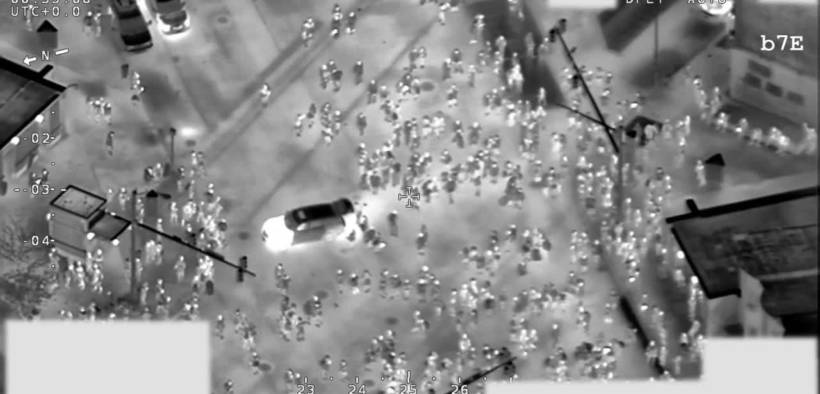Baltimore Testing Aerial Surveillance to Counter Rising Homicide Rate

“If that happened in real life, I think everyone would very clearly and viscerally understand the privacy implications, but because this is being done remotely with sophisticated video technology from an airplane, we don’t experience the invasion in the same way.”
London may have a citywide, closed-circuit television system, but on Friday, Baltimore will be technologically superior with the introduction of aerial surveillance. As part of a trial program, the city will accommodate up to three surveillance airplane circling overhead during the day, the Associated Press reported.
An Old Design Made New
The measure follows five years of 300 annual homicides. Last year, the city led the US in homicides per-capita with 349, Reigna Garcia Cano reported for the Associated Press. The city is now on pace with last year’s count, just three shy of the year-ago figure at this point in time.
The city contracted the surveillance service through Persistent Surveillance Systems (PPS) from Ohio. Baltimore residents may already be familiar with the setup — it was employed in 2016 following a rise in crime after an African American youth died in police custody. The surveillance program was cut after the public was made aware of it, despite the police department’s denial that it was supposed to be a secret program.
PSS estimated a full time operation could have cut crime rate by 20% to 30%, according to a report by the Police Foundation. During the trial program, it flew a Cessna 207 equipped with the company’s Hawkeye II surveillance system. Twelve cameras took photos every second, covering up to 32 square miles.
“During the short test in 2016, in the equivalent of two weeks of flying, we watched five murders and 18 shootings and provided that information to investigators. We look forward to supporting the people of Baltimore in their efforts to reduce major crime and we look forward to doing so in a very open and transparent way” said Ross McNutt, PSS president, in December.
The Police Foundation report concluded that while new technologies should be tried when situations cannot be controlled through traditional means, with the caveat “that civic leaders should always be attentive to the potential, unintentional harm to individuals, communities or the public’s sense of confidence and trust in the police that well-meaning crime control strategies can produce.”
No Expectation of Privacy
Privacy advocates, including David Rocah, senior American Civil Liberties Union attorney, are contesting the program, however. With eyes in the sky, Baltimore residents are treated no different than if they had a police office following them, he said.
“If that happened in real life, I think everyone would very clearly and viscerally understand the privacy implications, but because this is being done remotely with sophisticated video technology from an airplane, we don’t experience the invasion in the same way,” Rocah said.
US District Judge Richard Bennet ruled in favor of the Baltimore Police Department (BPD) on April 24 for the District Court for the District of Maryland, declaring that “far more intrusive warrantless surveillance techniques” had been upheld by other courts, including the Supreme Court.
PSS defended the program by citing the technological limitations of the photography. McNutt said the resolution of the photos would not be sufficient to discern distinctive features like faces, gender, and ethnicity. For vehicles too, it is incapable of identifying them by color, make, and model, let alone read license plates.
The system will be used in tandem with standard ground methods such as license plate readers, traffic cameras, and gunfire sound detectors. Once notified of a crime, analysts will be able to use the city-wide photos and investigate people who traveled to and from the scene, possibly even tracking them across the city.
BPD will only use the overhead footage for solving “homicides, non-fatal shootings, armed robberies, and carjackings,” Police Commissioner Michael Harrison said.
Candidate Makes it an Election Issue
The surveillance program could play a role in the upcoming election for Baltimore mayor. A Baltimore Sun-University of Baltimore-WYPR found that half of respondents believe reducing crime is the number one task for the next mayor. That was before the coronavirus pandemic, however.
Mayor Bernard “Jack” Young is seeking reelection, but he is running against several candidates including City Council President Brandon Scott who are resistant to the surveillance idea.
“When you don’t have a (crime-fighting) plan, you reach for boxing rings. You hope for cold weather. You say you’ll put a surveillance plane up in the sky that does not work,” Scott said. “We need solutions that work, and Commissioner Harrison has told the City Council multiple times this year, as recently as October, that there is no evidence the surveillance plane is an effective crime-fighting tool.”
The Democratic primary is slated for June 2, which will be one month after PSS begins its pilot program on Friday. By the time of the general election, the operation is scheduled to be finished, which would potentially allow for results and feedback to become a factor at the voting booth.







